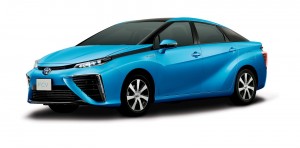The more I learn about hydrogen fuel cells as a potential alternative (or competitor) to battery electric vehicles, the more confused I become.
Hydrogen as a fuel source (as opposed to electricity) is much more energy intensive to produce and much less efficient as a result, given the energy input to make the hydrogen that will power the vehicle. It also requires building an entirely new fueling infrastructure to reach drivers, whereas electricity is ubiquitous (although does require a lot of new charging stations).
Hydrogen also isn’t cheap (per paywalled Greenwire):
Hydrogen fuel-cell vehicles could offer advantages over the electric cars on the road now, including higher travel distances between refuelings. Filling up the tank is basically the same as filling a car with gasoline, and in California, most hydrogen pumps are at existing gas stations. While the hydrogen fuel is significantly more expensive — filling a tank costs about $75 — Toyota and Honda give their customers credit for $15,000 worth of fuel over three years of ownership.
So why the big push for hydrogen in places like California, when battery electric vehicles have taken hold with billions of investment from companies around the world?
The answer appears to be Japan, and the automakers in that country, specifically Toyota and Honda. States like California have had to include hydrogen incentives in packages with battery electric vehicles in order to get the political buy-in from these Japanese automakers.
So with all the hurdles associated with hydrogen fuel cells, why is Japan so invested in the technology? Per ClimateWire (also pay-walled):
A big part of the answer is that the shift toward hydrogen plays to Japan’s strengths as a technology developer and exporter, and the country makes an ideal laboratory to test the hydrogen economy.
The country spends more than $100 billion on foreign oil every year, and fuel prices tend to be high, so hydrogen fuel doesn’t have to be as cheap as it does in other countries to compete. More than 93 percent of Japan’s population is concentrated in urban areas, so fewer fueling stations are needed to sustain a hydrogen fleet than among populations that are more spread out.
For drivers, a fuel cell fill-up takes only a few minutes, compared with hours of charging for a battery-electric vehicle.
Another factor is that much of the supply chain for the hydrogen economy is domestic, and Japanese companies like Toyota have a track record of bringing fuel-efficient cars to the masses.
In particular, Toyota has built the Prius, a mass-market hybrid gasoline-electric car that has dominated the segment for more than 20 years. It took 10 years to sell the first million units, then two years to sell the second million.
With patience and know-how, Toyota hopes to replicate some of that success in fuel cells in Japan and in other parts of the world where energy prices, environmental concerns and driving styles align to make fuel-cell-powered cars a preferable option.
I suppose it’s fine to have another “clean” vehicle technology in the mix, in case breakthroughs help it leapfrog battery electric vehicles. But I would prefer that policy makers don’t share too much of the limited available incentive dollars with this technology and instead focus on the more optimal solution.



